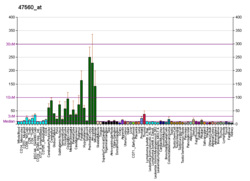Latrophilin 1
Latrophilin 1 is a protein that in humans is encoded by the ADGRL1 gene.[5][6] It is a member of the adhesion-GPCR family of receptors. Family members are characterized by an extended extracellular region with a variable number of protein domains coupled to a TM7 domain via a domain known as the GPCR-Autoproteolysis INducing (GAIN) domain.[7][8][9]
Function
This gene encodes a member of the latrophilin subfamily of G protein-coupled receptors (GPCR). Latrophilins may function in both cell adhesion and signal transduction. In experiments with non-human species, endogenous proteolytic cleavage within a cysteine-rich GPS (G-protein-coupled-receptor proteolysis site) domain resulted in two subunits (a large extracellular N-terminal cell adhesion subunit and a subunit with substantial similarity to the secretin/calcitonin family of GPCRs) being non-covalently bound at the cell membrane. Latrophilin-1 has been shown to recruit the neurotoxin from black widow spider venom, alpha-latrotoxin, to the synapse plasma membrane.[6]
See also
References
- ^ a b c ENSG00000288324 GRCh38: Ensembl release 89: ENSG00000072071, ENSG00000288324 – Ensembl, May 2017
- ^ a b c GRCm38: Ensembl release 89: ENSMUSG00000013033 – Ensembl, May 2017
- ^ "Human PubMed Reference:". National Center for Biotechnology Information, U.S. National Library of Medicine.
- ^ "Mouse PubMed Reference:". National Center for Biotechnology Information, U.S. National Library of Medicine.
- ^ Hayflick JS (Jan 2001). "A family of heptahelical receptors with adhesion-like domains: a marriage between two super families". Journal of Receptor and Signal Transduction Research. 20 (2–3): 119–31. doi:10.3109/10799890009150640. PMID 10994649.
- ^ a b "Entrez Gene: LPHN1 latrophilin 1".
- ^ Stacey M, Yona S (2011). AdhesionGPCRs: Structure to Function (Advances in Experimental Medicine and Biology). Berlin: Springer. ISBN 1-4419-7912-3.
- ^ Fredriksson R, Lagerström MC, Höglund PJ, Schiöth HB (Nov 2002). "Novel human G protein-coupled receptors with long N-terminals containing GPS domains and Ser/Thr-rich regions". FEBS Letters. 531 (3): 407–14. doi:10.1016/S0014-5793(02)03574-3. PMID 12435584.
- ^ Araç D, Boucard AA, Bolliger MF, Nguyen J, Soltis SM, Südhof TC, Brunger AT (Mar 2012). "A novel evolutionarily conserved domain of cell-adhesion GPCRs mediates autoproteolysis". The EMBO Journal. 31 (6): 1364–78. doi:10.1038/emboj.2012.26. PMC 3321182. PMID 22333914.
Further reading
- Südhof TC (2001). "alpha-Latrotoxin and its receptors: neurexins and CIRL/latrophilins". Annual Review of Neuroscience. 24: 933–62. doi:10.1146/annurev.neuro.24.1.933. PMID 11520923.
- Ushkaryov YA, Volynski KE, Ashton AC (Apr 2004). "The multiple actions of black widow spider toxins and their selective use in neurosecretion studies". Toxicon. 43 (5): 527–42. doi:10.1016/j.toxicon.2004.02.008. PMID 15066411.
- Nagase T, Ishikawa K, Suyama M, Kikuno R, Hirosawa M, Miyajima N, Tanaka A, Kotani H, Nomura N, Ohara O (Dec 1998). "Prediction of the coding sequences of unidentified human genes. XII. The complete sequences of 100 new cDNA clones from brain which code for large proteins in vitro". DNA Research. 5 (6): 355–64. doi:10.1093/dnares/5.6.355. PMID 10048485.
- Kreienkamp HJ, Zitzer H, Gundelfinger ED, Richter D, Bockers TM (Oct 2000). "The calcium-independent receptor for alpha-latrotoxin from human and rodent brains interacts with members of the ProSAP/SSTRIP/Shank family of multidomain proteins". The Journal of Biological Chemistry. 275 (42): 32387–90. doi:10.1074/jbc.C000490200. PMID 10964907.
- Brill LM, Salomon AR, Ficarro SB, Mukherji M, Stettler-Gill M, Peters EC (May 2004). "Robust phosphoproteomic profiling of tyrosine phosphorylation sites from human T cells using immobilized metal affinity chromatography and tandem mass spectrometry". Analytical Chemistry. 76 (10): 2763–72. doi:10.1021/ac035352d. PMID 15144186.
- Bjarnadóttir TK, Fredriksson R, Höglund PJ, Gloriam DE, Lagerström MC, Schiöth HB (Jul 2004). "The human and mouse repertoire of the adhesion family of G-protein-coupled receptors". Genomics. 84 (1): 23–33. doi:10.1016/j.ygeno.2003.12.004. PMID 15203201.
External links
- PDBe-KB provides an overview of all the structure information available in the PDB for Mouse Adhesion G protein-coupled receptor L1
This article incorporates text from the United States National Library of Medicine, which is in the public domain.







